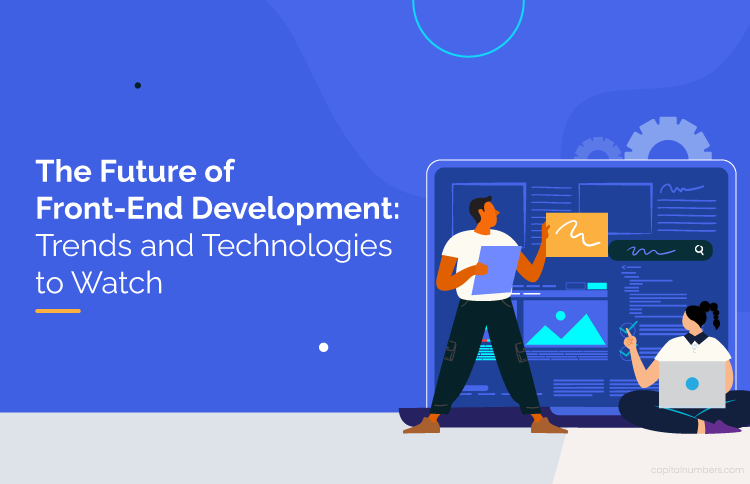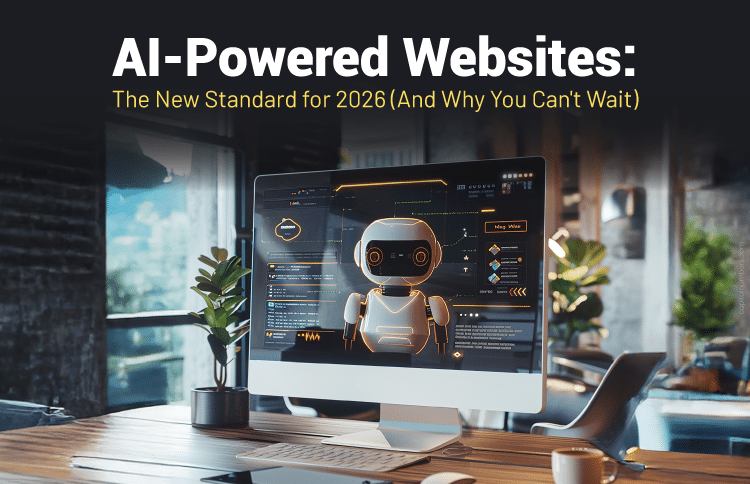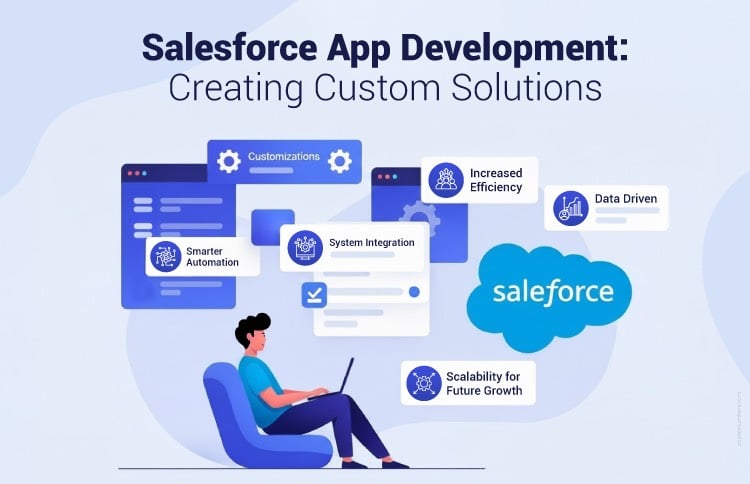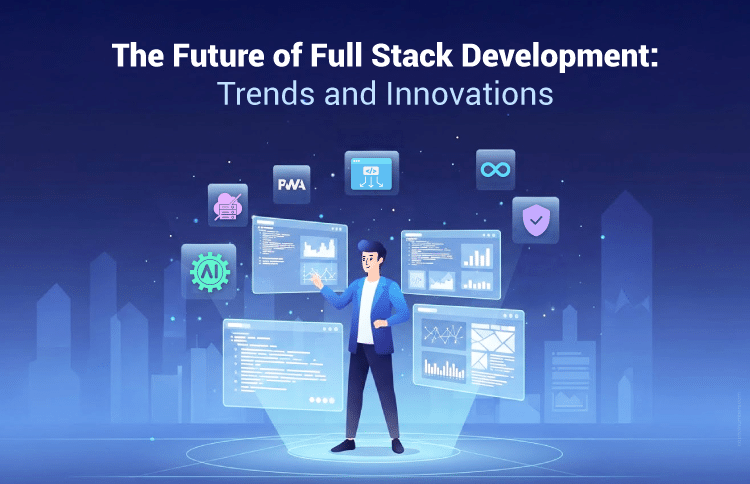The Future of Front-End Development: Trends and Technologies to Watch
Table of Contents
The world of front-end development is constantly changing. To stay ahead, it’s crucial to keep up with the latest tools, frameworks, and techniques. By understanding the key trends and technologies shaping the future of web development, you can create digital platforms that deliver exceptional user experiences.
This blog will explore these trends in detail, helping you stay ahead of the curve.
Trend #1: Rise of JAMstack Architecture
What is JAMstack?
JAMstack is a modern web development architecture that stands for JavaScript, APIs, and Markup. It decouples the front-end (client-side) from the back-end (server-side) of a web application. This separation allows for faster loading times, better performance, and increased security.
How JAMstack Works:
- Front-end: The client-side of a JAMstack application is typically built using static HTML, CSS, and JavaScript. This code is pre-rendered and delivered to the browser as static files.
- APIs: Back-end logic and data are handled by APIs, which are separate from the front-end. This allows for scalability and flexibility.
- Markup: The HTML markup for the front-end can be pre-rendered or generated dynamically using server-side rendering techniques.
Why JAMstack is Popular:
- Faster loading times: JAMstack applications load faster because they are served as static files, reducing the need for server-side processing.
- Better performance: JAMstack applications are often more scalable and performant than traditional server-side rendered applications.
- Increased security: By separating the front-end and back-end, JAMstack applications can be more secure and less vulnerable to attacks.
- Improved developer experience: JAMstack can simplify development workflows and make it easier to build and maintain web applications.
Future Potential of JAMstack:
JAMstack is expected to continue growing in popularity as more developers and businesses recognize its benefits. The future of JAMstack includes:
- Advancements in serverless functions: The integration of serverless functions will further enhance the flexibility and scalability of JAMstack applications.
- Improved developer tools: The development of new tools and frameworks will make it easier to build and manage JAMstack applications.
- Increased adoption in enterprise environments: JAMstack is expected to become more widely adopted by large enterprises.
In conclusion, JAMstack is a powerful architecture that offers many advantages for building modern web applications. As the technology continues to evolve, JAMstack is likely to become even more popular and influential in the future of web development.
Trend #2: Component-Based Development with Modern Frameworks
Rise of Component-Based Architecture
Component-based development is a software development approach that breaks down complex applications into smaller, reusable components. This modular structure enhances scalability, maintainability, and reusability.
Modern Frameworks Leading the Way
Frameworks like React, Vue.js, Angular, and Svelte are at the forefront of component-based development. These frameworks provide powerful tools and abstractions that make it easier to build and manage complex user interfaces.
Benefits of Component-Based Development
- Improved code reusability: Components can be reused across different parts of an application, reducing development time and effort.
- Enhanced scalability: Components can be scaled independently, making it easier to maintain and update large applications.
- Better organization: Component-based architecture promotes a more organized and modular codebase, improving readability and maintainability.
Popular Component-Based Frameworks
- React: A popular JavaScript library for building user interfaces. It uses a declarative paradigm and virtual DOM for efficient rendering.
- Vue.js: A progressive JavaScript framework known for its simplicity and flexibility. It offers a flexible component system and a clear API.
- Svelte: A compiler-based framework that compiles components into highly efficient JavaScript code. It offers excellent performance and a concise syntax.
- Angular: A comprehensive JavaScript framework that provides a full-featured platform for building web applications. It includes features like dependency injection, routing, and form handling.
The Future of Component-Based Development
Component-based architecture is expected to continue to evolve and gain popularity in the future. Some potential trends include:
- Micro front-ends: Breaking down large applications into smaller, independent front-ends that can be developed and deployed independently.
- Server-side rendering (SSR): Combining the benefits of client-side rendering with server-side rendering to improve SEO and initial page load times.
- Emerging frameworks: The development of new component-based frameworks with innovative features and capabilities.
As component-based development continues to mature, we can expect to see even more sophisticated and efficient web applications built with these frameworks.
You May Also Read: Angular vs. React vs. Vue.js: Which is the Best Front-End Framework for Your Web App?
Trend #3: Server-Side Rendering (SSR) and Static Site Generation (SSG)
SSR and SSG: What’s the Difference?
- Server-Side Rendering (SSR) involves rendering the HTML for a web page on the server before sending it to the client. This allows search engines to index the content effectively and improves initial page load times.
- Static Site Generation (SSG) involves pre-rendering all pages of a website as static HTML files. These files are then served directly to the client, resulting in extremely fast load times and excellent performance.
Popular Tools for SSR and SSG
- Next.js: A popular React framework that supports both SSR and SSG.
- Nuxt.js: A Vue.js framework that offers built-in support for SSR and SSG.
- Gatsby: A static site generator built on React that is optimized for performance and SEO.
Why SSR and SSG Matter
- Improved SEO: Search engines can index pre-rendered HTML pages more effectively, leading to better search rankings.
- Faster load times: SSR and SSG can significantly improve the perceived performance of web applications, especially for users with slower internet connections.
- Enhanced user experience: Faster load times and improved SEO can lead to a better overall user experience.
The Growing Trend of Hybrid Approaches
Many modern web applications combine SSR and SSG to achieve the best of both worlds. This approach can be particularly effective for websites with dynamic content, such as e-commerce platforms or blogs.
The Future of SSR and SSG
SSR and SSG are expected to continue to play a significant role in web development. As technology advances, we can expect to see even more innovative approaches to SSR and SSG, such as incremental static regeneration and serverless functions.
In conclusion, SSR and SSG are essential tools for building high-performance and SEO-friendly web applications. By understanding the differences between these two techniques and choosing the right approach for your project, you can create exceptional user experiences and drive business success.
Trend #4: Motion UI and Advanced Animations
Introduction to Motion UI
Motion UI is the practice of adding transitions and animations to web interfaces to enhance the user experience. By incorporating well-designed motion, front-end developers can create more engaging, intuitive, and visually appealing websites.
Importance of Animations in Modern UX
Animations can significantly improve the user experience by:
- Providing visual feedback: Animations can indicate the status of actions, providing users with immediate feedback.
- Enhancing engagement: Motion can make websites more visually appealing and interactive, keeping users engaged.
- Improving usability: Animations can guide users through the interface and make it easier to navigate.
- Adding personality: Animations can help a website stand out and reflect the brand’s personality.
Popular Tools and Libraries for Implementing Motion UI
- GreenSock Animation Platform (GSAP): A powerful JavaScript library for creating complex animations.
- Framer Motion: A React-based animation library that offers a simple and declarative API.
- Animate.css: A collection of pre-built CSS animations that can be easily integrated into websites.
The Future of Motion UI
The trend toward more immersive and interactive web experiences is expected to continue, driving the demand for advanced motion UI techniques. In the future, we can expect to see:
- More complex animations: The use of more sophisticated animations, such as 3D effects and physics-based motion.
- Integration with virtual and augmented reality: The application of motion UI techniques to create immersive AR and VR experiences.
- Improved performance: The development of new tools and techniques for creating efficient and performant animations.
As technology advances, motion UI will play an increasingly important role in creating engaging and memorable web experiences.
Ready to enhance your website’s performance and user experience? Hire our expert front-end developers to create visually stunning, user-friendly, and high-performing websites.
Trend #5: Headless CMS and Content Management Evolution
What is a Headless CMS?
A headless content management system (CMS) is a type of CMS that separates the content management backend from the front-end presentation layer. This decoupling allows for greater flexibility and scalability in content delivery.
Popular headless CMS examples:
- Strapi: An open-source, Node.js-based headless CMS.
- Contentful: A cloud-based headless CMS with a flexible API.
Why Headless CMS is Gaining Popularity
- Flexibility: Headless CMS allows developers to choose the best front-end tools and frameworks for their projects, providing greater flexibility in design and development.
- Omnichannel content delivery: Headless CMS makes it easier to deliver content across multiple channels, such as websites, mobile apps, IoT devices, and social media.
- Scalability: Headless CMS can handle large-scale content management and delivery, making it suitable for enterprises with complex content needs.
- Developer-friendly: Headless CMS often have a developer-friendly API and can be easily integrated with other systems.
The Future of Headless CMS
- Continued growth: Headless CMS is expected to continue growing in popularity as businesses seek more flexible and scalable content management solutions.
- Integration with other technologies: Headless CMS will likely integrate more closely with other technologies, such as AI, machine learning, and IoT.
- New features and capabilities: Headless CMS platforms will continue to evolve, offering new features and capabilities to meet the changing needs of businesses.
By adopting a headless CMS, businesses can improve their content management capabilities, enhance their digital experiences, and drive growth.
You May Also Read: A Step-by-Step Guide to Build a Headless WordPress Website with React
Future of Front-End Development: Integrating Emerging Technologies
Augmented Reality (AR) and Virtual Reality (VR)
AR/VR development is transforming industries such as e-commerce, education, and entertainment by providing immersive, interactive experiences. As these technologies become more accessible and affordable, their influence on front-end development is expected to grow significantly, reshaping how users interact with digital platforms.
Examples of front-end frameworks and libraries that support AR/VR development:
- React VR: A framework for building VR experiences using React.
- A-Frame: A web framework for building VR experiences using HTML, CSS, and JavaScript.
- Three.js: A JavaScript library for creating and displaying 3D graphics in a web browser.
The Impact of 5G on Front-End Development
5G technology promises to deliver significantly faster internet speeds and lower latency. This will enable richer, more dynamic web experiences, including:
- Real-time collaboration: Seamless collaboration between users, regardless of their location.
- High-quality streaming: Streaming of high-definition video and audio content with minimal buffering.
- Augmented reality and virtual reality: More immersive and interactive AR/VR experiences.
As 5G becomes more widespread, front-end developers will need to adapt their applications to take advantage of the increased bandwidth and lower latency.
Conclusion
The future of front-end development is promising, with exciting trends like JAMstack, component-based architecture, SSR/SSG, motion UI, AR/VR, and 5G shaping the landscape. Businesses can leverage these trends to create more engaging, performant, and innovative web experiences that drive customer satisfaction and business growth.
Ready to stay ahead of the curve? Contact us today to discuss how our front-end development team can help you achieve your goals.















